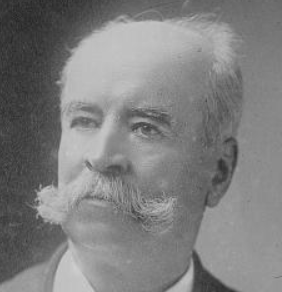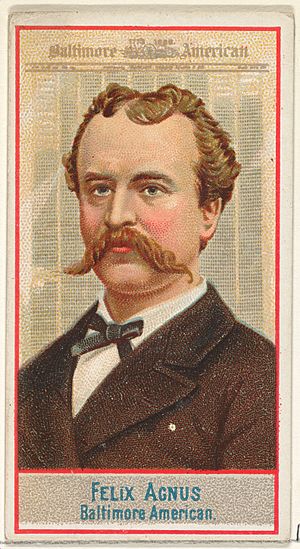Felix Agnus facts for kids
Quick facts for kids
Felix Agnus
|
|
|---|---|
 |
|
| Born | 4 July 1839 Lyon, France |
| Died | 31 October 1925 (aged 86) |
| Buried |
Druid Ridge Cemetery
|
| Allegiance |
|
| Service/ |
French Army Union Army |
| Years of service | 1859 (France) 1861–1865 (US) |
| Rank | |
| Battles/wars | Franco-Austrian War American Civil War |
| Awards | Ordre du Nichan El-Anouar |
| Children | 2 |
| Other work | Publisher of the Baltimore American |
| Signature | |
Felix Agnus was born in France on July 4, 1839. He was a talented sculptor, a successful newspaper publisher, and a brave soldier. He fought in two major wars: the Franco-Austrian War and the American Civil War.
After his military service, Agnus moved to Baltimore. There, he started working for the Baltimore American newspaper. He eventually became its publisher, making it a very important newspaper. He was also a founding member of the Associated Press. Felix Agnus passed away in 1925. A famous statue, known as Black Aggie, was once on his grave and is now part of many local legends.
Contents
Early Life and Adventures
Felix Agnus was born in Lyon, France. His parents were Etienne and Anne Agnus. He went to school near Paris at College Jolie Clair.
When he was 13, in 1852, he went on a four-year trip around the world. After returning, he began studying to become a sculptor. However, he stopped his studies to join the army.
He fought in the Franco-Austrian War in 1859. He was part of the 3rd Regiment and took part in the Battle of Montebello. After the war, he moved from France to the United States. He first lived in Newport, Rhode Island, then in New York City. In New York, he worked for Tiffany and Company, a famous jewelry store.
Fighting in the Civil War
When the American Civil War began on April 25, 1861, Felix Agnus joined the Union Army. He became part of a special unit called Duryée's Zouaves. He quickly showed his bravery.
At the Battle of Big Bethel, he saved the life of Captain Judson Kilpatrick. Because of his courage, he was promoted several times. He became a sergeant, then a second lieutenant, and then a first lieutenant.
During the Peninsula Campaign, Agnus led a charge at Ashland Bridge. He was badly wounded in the shoulder at the Battle of Gaines's Mill. While recovering, his unit was stationed in Baltimore. He stayed at the home of Charles C. Fulton, who published the Baltimore American. It was likely there that he met Fulton's daughter, Annie, who he later married.
He helped create four new companies for the 165th New York Infantry Regiment. He was made captain of a special company within this regiment.
Service in the South
In late 1862, his regiment went to Louisiana. They were stationed in New Orleans and Baton Rouge. Captain Agnus was wounded again on May 27, 1863, during the siege of Port Hudson. On September 2, he was promoted to major. For a time, he was even in command of his entire regiment.
He also served in Texas. After becoming a lieutenant-colonel, he joined the 19th Corps. He fought under General Philip Sheridan in several battles. These included Opequon, Fisher's Hill, Winchester, and Cedar Creek.
His last job in the army was in the Department of the South. He was an inspector general, which meant he was in charge of checking military property. He oversaw the dismantling of old Confederate forts in South Carolina, Georgia, and Florida. He made sure all the property was given to the U.S. government.
On March 13, 1865, he was given the honorary rank of brevet brigadier general. This made him the youngest brigadier general in the army at that time. Felix Agnus left the army on August 22, 1865.
Life After the War
After the war, Felix Agnus returned to civilian life. He was appointed as an assistant assessor in the tax office in Baltimore. On July 4, 1869, he started working for the business department of the Baltimore American newspaper. He eventually became its publisher.
Agnus worked hard to make the newspaper much bigger and more successful. In 1904, a large fire, known as the Great Baltimore Fire, destroyed the American's headquarters. Agnus quickly found other places to print the paper. He then began building a new, tall building for the newspaper. Agnus also started another newspaper called the Baltimore Star. He sold both newspapers on December 1, 1924, to Frank Munsey.
Felix Agnus was a respected citizen. He was asked twice to run for a seat in the United States Senate, but he said no. He was also offered the job of US Consul in Derry, Ireland, but he declined that too. He served on many important groups. He was the chairman of the Chesapeake and Delaware Canal Commission. He was also a member of the Board of Visitors for West Point, a famous military academy. He helped with the commission that built the Baltimore Courthouse.
Agnus was one of the first members of the Associated Press. He was also a delegate to several national meetings for the Republican Party. He was a founding member of the Army and Navy Club. He received a special award called the Ordre du Nichan El-Anouar.
Felix Agnus died on October 31, 1925. A marching song called "General Felix Agnus March" was written in his honor in 1882.
The Black Aggie Statue
Black Aggie is the popular name for a statue that used to be on Felix Agnus's grave. It was located in Druid Ridge Cemetery in Pikesville, Maryland. The statue shows a sad figure sitting down, covered in a cloak. Many urban legends and spooky stories grew up around this statue.


